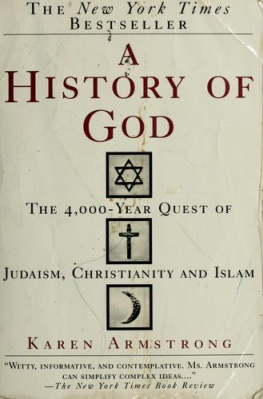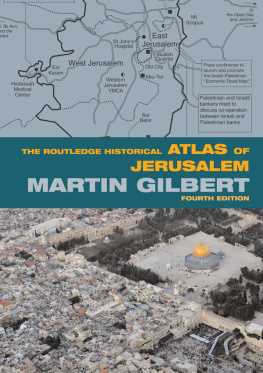More praise for Jerusalem
An immensely erudite chronicle Armstrongs step-by-step march down the years shows how a succession of spiritual decisions and political circumstances passed the city from faith to faith.
Time
Armstrongs clear, authoritative voice engages us because she takes seriously the spiritual experience of Jerusalem as imputed to the city by its residents, conquerors, and propagandists over the centuries.
San Francisco Chronicle
A comprehensive, fascinating, and readably accessible history of Jerusalem as the Holy City, venerated for thirty centuries by Jews, Christians, and Muslims.
The Denver Post
[Armstrong] brings to her sweeping, profusely illustrated narrative a grasp of sociopolitical conditions seldom found in other books.
Publishers Weekly
2005 Ballantine Books Trade Paperback Edition
Copyright 1996, 1997 by Karen Armstrong
Architectural plans copyright 1996 by John Field
Maps copyright 1996 by Mark Stein Studios
Preface copyright 2005 by Karen Armstrong
Reading group guide copyright 2005 by Random House, Inc.
All rights reserved.
Published in the United States by Ballantine Books, an imprint of The Random House Publishing Group, a division of Random House, Inc., New York.
BALLANTINE and colophon are registered trademarks of Random House, Inc.
RANDOM HOUSE READERS CIRCLE and colophon are trademarks of Random House, Inc.
Originally published in hardcover in the United States by Alfred A. Knopf, a division of Random House, Inc., in 1996.
eISBN: 978-0-307-79859-6
www.randomhousereaderscircle.com
Excerpt from Twelve Steps to a Compassionate Life copyright 2010 by Karen Armstrong
v3.1
For my mother, Eileen Armstrong
Contents
Maps and Diagrams
Preface
This book was first published in 1996. At that time, the situation in Jerusalem looked extremely grave and it was difficult to see how the conflict between the Israelis and the Palestinians could be resolved. But at least people were talking about peace. Despite the tragic death of President Yitzhak Rabin, the Oslo Accords were still in place, and, though there were obvious difficulties and religious extremists on both sides continued to oppose a peaceful settlement, progress was made. Both the Israelis and the Palestinians benefited from the cessation of hostilities, politically, socially, and economically. As I write this, in the fall of 2004, this seems a halcyon period. The situation in the Middle East has deteriorated and now threatens the security of the entire planet. Our world has irrevocably changed and yet it is also true that in Jerusalem not very much has changed at all.
In the summer of 2000, Ariel Sharon marched onto the Haram al-Sharif with a crowd of supporters, a symbolic gesture designed to be provocative. Sharon was regarded as the architect of the settlement movement in Gaza and the West Bank. Now he was tacitly threatening to occupy the Temple Mount. Immediately, violence broke out in Jerusalem and the Second Intifadah began. It was the beginning of the end of the peace process. Today the Oslo Accords are in ruins, Palestinian militants have launched a devastating series of suicide bombing attacks, and the death toll on both sides of the conflict has been horrific.
On September 11, 2001, nineteen members of al-Qaeda, a terrorist organization headed by the Muslim extremist Osama bin Laden, attacked the World Trade Center and the Pentagon. This has inevitably affected the situation in Israel and Palestine. Relations between the Islamic world and the West have reached an all-time low, and Jerusalem can be regarded as the bleeding heart of the problem. All sides continue to identify with it at a profound level.
For Jews, the possession of the Holy City continues to have healing power; they see Jewish Jerusalem rising phoenix-like from the ashes of Auschwitz. In constant danger from suicide bombing attacks, an increasing number of Israelis can no longer imagine sharing the city with the Palestinians. Muslims also feel beleaguered as a result of the war against terror launched by the United States after September 11. Many see the loss of Muslim Jerusalem as a symbol of their impotence in the modern world.
In the United States, the Christian Right has also hardened its position. They have long believed that the final battle of Armageddon will be fought outside the city, and that Jews must be present in the Holy Land in order to fulfil the ancient prophecies (even though all unbaptised Jews will be massacred by the Antichrist). During the Cold War, Christian fundamentalists regarded the Soviet Union as the Antichrist; since September 11, they have come to believe that Islam will fulfill this role. Their apocalyptic views undoubtedly have an influence on American policy in the Middle East.
And yet, as this book shows, Jerusalem has for centuries been a symbol, surrounded in peoples minds with an aura of associations that has made it sacred. They found their God in the Holy City and it thus became inseparable from their deepest selves. People have always experienced God not simply as a transcendent reality out there but also in the ground of their being. When Jerusalem was threatened, they felt personally attacked; when its sanctity was violated, they experienced this as a rape. Today everybody feels threatened; everybody is in danger; everybody is on high alert in the expectation of a terrorist attack. As a result, Jerusalem has become more sacred to their identity than ever before.
This book traces the explosive history of Jerusalem, and the atrocities that have been committed in its name. But it also shows that for centuries, Jews, Christians, and Muslims were able to live together there. Peaceful coexistence in the Holy City is not an impossible dream. If Jerusalem has become the symbolic heart of the conflict that now threatens the whole world, then a solution is a matter of the highest importance. It will require imagination and commitment to find a solution to the problem of Jerusalem; everybody will have to make sacrifices; everybody will have to compromise in the interests of peace. But people were able to share the Holy City once, and they can therefore, do it again.
Acknowledgments
Writing is a solitary and sometimes lonely occupation, but I should like to thank my agents, Felicity Bryan, Peter Ginsberg, and Andrew Nurnberg, as well as my editors, Jane Garrett and Stuart Proffitt, for their support and encouragement. I am also grateful to Roger Boase, Claire Bradley, Juliet Brightmore, Katherine Hourigan, Ted Johnson, Anthea Lingeman, Jonathan Magonet, Toby Mundy, and Melvin Rosenthal for their expertise, patience, advice, and help. Finally, my thanks to Joelle Delbourgo, my erstwhile editor at Ballantine, who first suggested that I write this book and always gave me the benefit of her immense enthusiasm and encouragement.
Introduction
In Jerusalem, more than in any other place I have visited, history is a dimension of the present. Perhaps this is so in any disputed territory, but it struck me forcibly the first time I went to work in Jerusalem in 1983. First, I was surprised by the strength of my own reaction to the city. It was strange to be walking around a place that had been an imaginative reality in my life ever since I was a small child and had been told tales of King David or Jesus. As a young nun, I was taught to begin my morning meditation by picturing the biblical scene I was about to contemplate, and so conjured up my own image of the Garden of Gethsemane, the Mount of Olives, or the Via Dolorosa. Now that I was going about my daily business among these very sites, I discovered that the real city was a far more tumultuous and confusing place. I had, for example, to take in the fact that Jerusalem was clearly very important to Jews and Muslims too. When I saw caftaned Jews or tough Israeli soldiers kissing the stones of the Western Wall or watched the crowds of Muslim families surging through the streets in their best clothes for Friday prayers at the aram al-Sharif, I became aware for the first time of the challenge of religious pluralism. People could see the same symbol in entirely different ways. There was no doubting the attachment of any of these people to their holy city, yet they had been quite absent from















